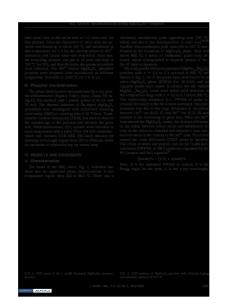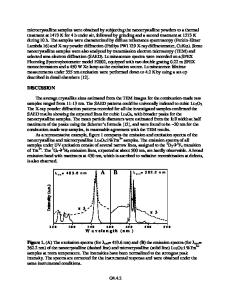Photoluminescence of Lu 2 O 3 :Eu 3+ phosphors obtained by glycine-nitrate combustion synthesis
- PDF / 339,051 Bytes
- 6 Pages / 612 x 792 pts (letter) Page_size
- 55 Downloads / 392 Views
Eu3+-doped Lu2O3 phosphors were synthesized through a novel solution combustion route using glycine as the fuel. The influence of the glycine-to-nitrate (G/N) mole ratio on the crystallite size, specific surface area, morphology, and photoluminescence of the synthesized phosphors was investigated. The ignition temperature on the properties of the products was also studied. With G/N ratio increasing from 1.0 to 1.7, the grain size increased from 35 to 118 nm accordingly, resulting in the obvious changes of the photoluminescence properties. Concentration dependence of the emission intensity revealed that the quenching concentration of europium dopant was around 5 mol% for G/N ⳱ 1.7. The intensity of the peak emission due to the 5D0 → 7F2 transition of the Eu3+ ions dropped as the grain size decreased. The charge transfer band position of Eu3+-doped lutetia phosphors shifted toward lower energy (red shift) with the reduction of crystallite sizes and also with the increase of Eu3+ concentrations.
I. INTRODUCTION
Lu2O3 possesses the rare-earth C-type of cubic crystalline structure, which is the same as that of Y2O3.1 It is an excellent luminescent host material for laser and scintillator applications because of its high melting point (2450 °C), high thermoconductivity, low thermal expansion coefficient(4 × 10−7 K−1), and low effective phonon energy. Furthermore, Lu2O3 shows an extraordinarilly high absorption coefficient for ionizing radiation and thus very high stopping power for x-rays and ␥-rays, mostly due to its very high density (9.42 g/cm3) and Z number (71) of lutetium. Lutetia doped with Nd or Yb is a promising high-power ceramic laser material,2 while europium-doped Lu2O3 ceramic scintillators can be applied in the field of stationary digital imaging technology.3 Various synthesis procedures have been developed for preparing nanostructured phosphors, which are believed to have potential exceeding that of their classic micronsized counterparts. Conventional phosphor synthesis techniques using solid-state reactions have disadvantages in maintaining the uniformity of composition and improving the morphology, size, and size distribution of phosphor particles. In contrast, wet-chemical processing of multi-cation oxides provides considerable advantage,
a)
Address all correspondence to this author. e-mail: [email protected] DOI: 10.1557/JMR.2005.0183 J. Mater. Res., Vol. 20, No. 6, Jun 2005
http://journals.cambridge.org
Downloaded: 30 Mar 2015
including good mixing of the starting materials and excellent chemical homogeneity of the final product. Recently, solution combustion synthesis has been widely used to synthesize complex oxides such as Y2O3:Eu,4 (Gd,Y)2O3:Eu,5 Y3Al5O12:Cr,6 and a large variety of other ceramic powders.7,8 The propellant synthesis process involves the exothermic reaction initiated by an oxidizer such as metal nitrate and an organic fuel, typically urea (CH4N2O), glycine (C2H5NO2), and carbohydrozide (CH6N4O).6 It appeared to be promising for phosphor synthesis because of its success in c
Data Loading...











